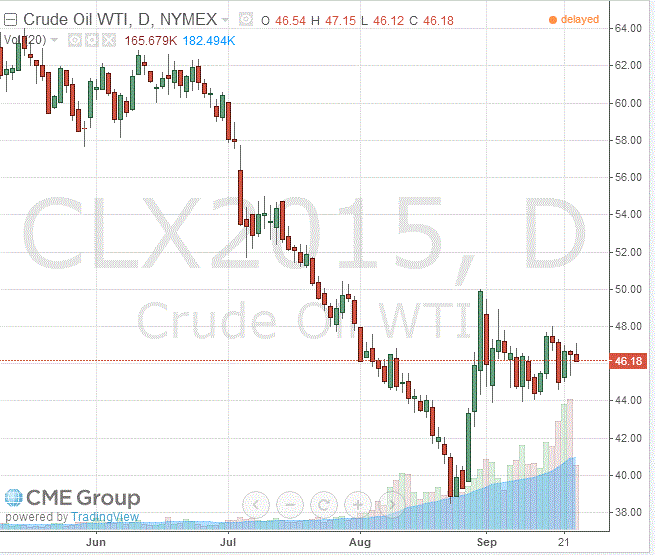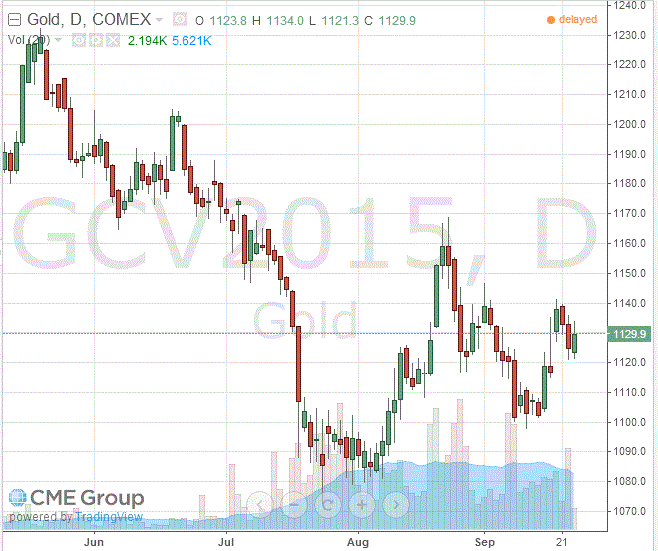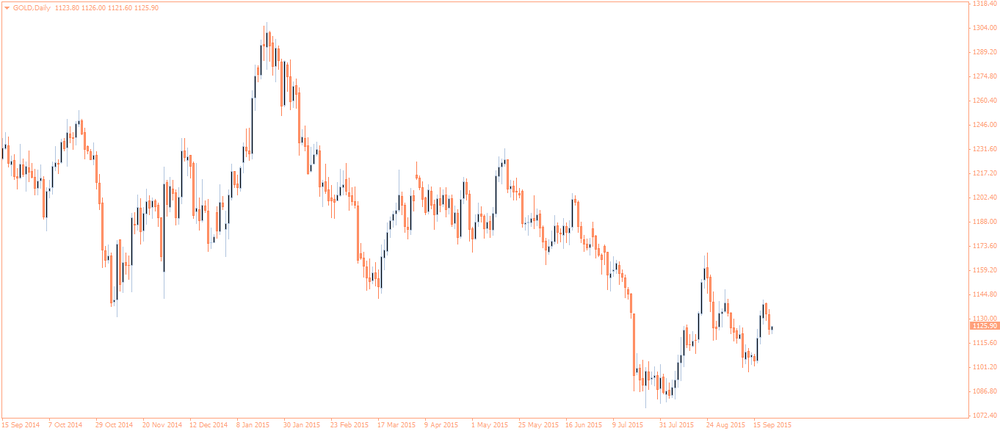Noticias del mercado
-
17:44
Oil prices fall despite a drop in U.S. oil inventories
Oil prices declined despite a drop in U.S. oil inventories. The U.S. Energy Information Administration (EIA) released its crude oil inventories data on Wednesday. U.S. crude inventories fell by 1.9 million barrels to 454.0 million in the week to September 18.
Analysts had expected U.S. crude oil inventories to decline by 1.5 million barrels.
Gasoline inventories increased by 1.4 million barrels, according to the EIA.
Crude stocks at the Cushing, Oklahoma, declined by 462,000 barrels.
U.S. crude oil imports fell by 13,000 barrels per day.
Refineries in the U.S. were running at 90.9% of capacity, up from 93.1% the previous week.
Concerns over the slowdown in the Chinese economy weighed on oil prices. The Chinese preliminary Markit/Caixin manufacturing Purchasing Managers' Index (PMI) decreased to 47.0 in September from 47.3 in August, missing expectations for a rise to 47.5, and hitting a 78-month low.
The output index fell to 45.7 in September from 46.4 in August, reaching a 78-month low. New orders, new export orders, employment, output prices and input prices also declined.
WTI crude oil for October delivery fell to $46.18 a barrel on the New York Mercantile Exchange.
Brent crude oil for October declined to $48.78 a barrel on ICE Futures Europe.
-
17:23
Gold price rises on a weaker U.S. dollar and as U.S. stock markets decline
Gold price increased on a weaker U.S. dollar and as U.S. stock markets declined. The preliminary U.S. manufacturing purchasing managers' index (PMI) for the U.S. weighed on the U.S. dollar. The U.S. preliminary manufacturing purchasing managers' index remained unchanged at 53 in September, in line with expectations. It is the lowest level since October 2013.
A reading above 50 indicates expansion in economic activity.
Higher expansion in output was offset by slower pace of expansion in new orders and employment.
Concerns over the slowdown in the Chinese economy also supported gold price. The Chinese preliminary Markit/Caixin manufacturing Purchasing Managers' Index (PMI) decreased to 47.0 in September from 47.3 in August, missing expectations for a rise to 47.5, and hitting a 78-month low.
The output index fell to 45.7 in September from 46.4 in August, reaching a 78-month low. New orders, new export orders, employment, output prices and input prices also declined.
October futures for gold on the COMEX today rose to 1129.90 dollars per ounce.
-
17:06
U.S. crude inventories decline by 1.9 million barrels to 454.0 million in the week to September 18
The U.S. Energy Information Administration (EIA) released its crude oil inventories data on Wednesday. U.S. crude inventories fell by 1.9 million barrels to 454.0 million in the week to September 18.
Analysts had expected U.S. crude oil inventories to decline by 1.5 million barrels.
Gasoline inventories increased by 1.4 million barrels, according to the EIA.
Crude stocks at the Cushing, Oklahoma, declined by 462,000 barrels.
U.S. crude oil imports fell by 13,000 barrels per day.
Refineries in the U.S. were running at 90.9% of capacity, up from 93.1% the previous week.
-
10:43
Chinese preliminary Markit/Caixin manufacturing Purchasing Managers' Index falls to 47.0 in September
The Chinese preliminary Markit/Caixin manufacturing Purchasing Managers' Index (PMI) decreased to 47.0 in September from 47.3 in August, missing expectations for a rise to 47.5, and hitting a 78-month low.
A reading below 50 indicates contraction of activity.
The output index fell to 45.7 in September from 46.4 in August, reaching a 78-month low. New orders, new export orders, employment, output prices and input prices also declined.
Dr. He Fan, Chief Economist at Caixin Insight Group, said that the index indicates that China's manufacturing industry "has reached a crucial stage in the structural transformation process".
"Overall, the fundamentals are good. The principle reason for the weakening of manufacturing is tied to previous changes in factors related to external demand and prices. Fiscal expenditures surged in August, pointing to stronger government efforts on the fiscal policy front. Patience may be needed for policies designed to promote stabilization to demonstrate their effectiveness," he added.
-
10:31
Chinese Academy of Social Science: the Chinese economy is expected to expand 6.9% in 2015
According to the government think-tank Chinese Academy of Social Science, the Chinese economy is expected to expand 6.9% in 2015, down from the previous estimate of a 7.0% growth.
The think-tank noted that the slowdown was driven by a decline in investment by firms and individuals and growing debt pressures faced by local governments.
-
08:36
Oil prices declined
West Texas Intermediate futures for November delivery fell to $46.23 (-0.28%), while Brent crude declined to $48.90 (-0.37%) as weak data on China's manufacturing intensified concerns over demand from the second-biggest oil consumer. A preliminary report from Markit Economics and Caixin Media showed on Wednesday that China's manufacturing sector had fallen to a six-and-a-half-year low of 47.0 in September. Economists had expected a 47.5 reading after 47.3 reported previously. A reading below 50 suggests contraction.
Late Tuesday, the American Petroleum Institute reported that U.S. crude-oil inventories fell 3.7 million barrels for the week ended September 18. This report temporarily boosted prices. The Energy Information Administration data will be released later today.
Thirteen analysts surveyed by the Wall Street Journal expect U.S. oil stocks to have fallen by 100,000 barrels, on average, in the same week.
-
08:33
Gold under pressure
Gold is currently under pressure at $1,125.00 (+0.02%) amid signs that the Federal Reserve can still raise rates in 2015. Several Federal Reserve's officials said on Monday that they still expect a rate hike by the end of the current year. Higher rate would harm non-interest-bearing bullion. Investors are also waiting for Fed Chair Yellen's speech scheduled for Thursday.
A preliminary report from Markit Economics and Caixin Media showed this morning that China's manufacturing sector had fallen to a six-and-a-half-year low of 47.0 in September. Economists had expected a 47.5 reading after 47.3 reported previously. This report weighed on stocks, but failed to support gold, which is a traditional safe-haven asset at times of crisis and economic uncertainties.
-
00:36
Commodities. Daily history for Sep 22’2015:
(raw materials / closing price /% change)
Oil 45.83 -1.8%
Gold 1,123.90-0.08%
-


